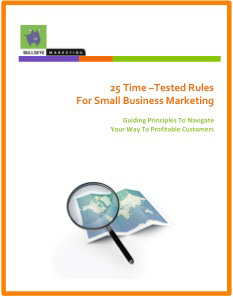Marketing Smarts Newsletter
Sept. 1, 2011
- Short and Sweet
- List Building for Profit - Part 1
- 5 Tips Today's Entrepreneurs Can Learn from (author) J.K. Rowling
|
|
 Greetings!!
I'm shortening this up this week so you can cut to the article on list building. It's a bit like putting a puzzle together and it's the most essential piece.
I've always known that you need a list to do any good marketing.
But Chip Doyle, my brilliant and talented sale coach of Sandler Sales, says "It's the list, the list, the list."
Short, poetic, true. It is all about the list. It's the map. Without it, you are directionless.
Have a wonderful Labor Day weekend.
Good Marketing,
Anne Kenney
Chief Wrangler
|

|
List Building for Profit - Part 1
You wouldn't drive a car not knowing where you're going. Is your business driving without directions?
You need a list of prospects. You need to know who you want as your client.
I often hear people say "Everyone is my client" or "Anyone who wants health is my client" or "Everyone has feet." These are 3 of the most self-delusional statements ever made. Everyone is not your client because they have to have money to buy from you. They have to have a problem that you can solve and they have to come across you to even buy from you.
Not to get too graphic but does a double-amputee have feet? Isn't everyone interested in their health? See, it's crazy to not narrow your list down.
Let's get real. You are a hunter. But, what kind of hunter? Rare coins? Birds? Purple strappy sandals? The more you know about what you're hunting, the more likely you are to find it.
Here's how you can get started:
You should know what kind of people or businesses you want to attract as clients. Who do you have already that you want more of? Who do have as clients that you want less of? And, who is not your client but you would like to have as a client?
See, now you're building your hunting/shopping list. When you sell to other businesses, you don't have to have specific company names but you do need a profile or idea of a company you're on the hunt for. When you sell to consumers, you need a list of people who you know or would like to know.
Then, you have to develop a profile of your prospective client:
1) Demographics - These are the statistics of your prospect. Those statistics include # of employees, amount of revenue, type of industry, where are they located, is it a private or public company. If you sell to individuals, you need to know if they are single or married or divorced or never married. Do they have kids? Do they have pets?
2) Psychographics - Male or female contact, how the company or person behaves: what's their buying behavior, where might you meet them (organizations they belong to), what do they read, what websites to they visit, what stage of development is they're company in, market they are in (who they market to), what's their business structure, do the own a home or rent, are they religious, do they collect things like coins or Chia Pets and so on.
It's okay if you develop several profiles (personas) of your ideal client. No company only has one ideal client. You probably should have 2 or 3. You may decide to divide it like small, medium, large or a, b, c.
For instance, a persona might be:
Mike Smith - he's a 45 year-old man who's created 3 companies in technology. His last two companies file bankruptcy. His current company is a web comparison site for a niche industry. He's hired a team of 6 people and his exit strategy is an acquisition by a larger company in the industry.
You can create a persona from some knowledge of a current client. You’re not divulging info but figuring out characteristics that make this a good fit for you.
Next week, I'll share how to build your list.
|
5 Tips Today's Entrepreneurs Can Learn From Author J. K. Rowling.
The celebrated, and now very wealthy, author of the Harry Potter book series, shared these ideas on the Open Forum by American Express. Ms. Rowling's story is so inspiring because it's about perseverance, persistence and sticking with a vision few others can see. Here are the invaluable tips but please read the article for expanded reporting.
Tip 1: Don’t rush to roll out your product
“Destiny is a name often given in retrospect to choices that had dramatic consequences.”
Tip 2: When a great idea grabs you, grab back
“You sort of start thinking anything's possible if you've got enough nerve.”
Tip 3: Persevere, persevere and persevere
“It is our choices...that show what we truly are, far more than our abilities.” Tip 4: Don’t let anyone sidetrack you from your goal
“If you're holding out for universal popularity, I'm afraid you will be in this cabin for a very long time.”
Tip 5: Each of us has a unique contribution to make to the world
“I just write what I wanted to write. I write what amuses me. It's totally for myself.”
|
Special Free Offer
 Have you received my new complimentary eBook,
25 Time-Tested Rules of Small Business Marketing?
In this eBook you learn the rules of marketing to successfully
generate profitable leads.
You'll discover how to prioritize
your demands on your limited resources, what are rules really work for
small business marketing and finding customers.
Subscribe Here
Discover:
- The #1 Rule is the must-read of all rules.
- Why Google is smarter than you and how you can get banned by them.
- Discover what your best marketing tool and your biggest marketing asset are.
- Find 3 big ideas for reaching the hard to reach prospect.
- Learn at least 2 ideas for lazy marketing.
- And, so much more.
|
|
Contact Details
Bullseye Marketing
Phone: (650) 345-3720
Fax: (650) 458-8158
send us email
© Bullseye Marketing 2011, All Rights Reserved
|
|
|
|
